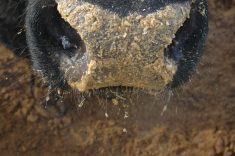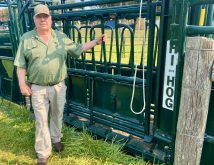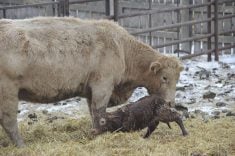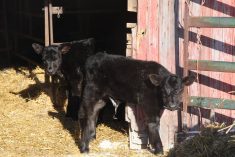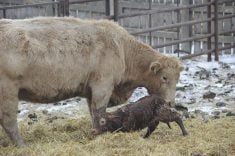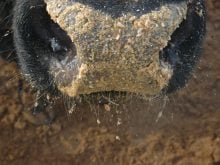Understanding the three stages of the bovine birthing process helps producers evaluate when or if they need to provide aid during calving.
“In general, producers have an intuitive sense as to the pathway to parturition. As a consulting veterinarian, I like to break that down into well-defined steps or stages so it’s more clearly defined in their mind when to watch those cattle closely, and also when to intervene so we can have a successful calving outcome,” said Cody Creelman, veterinarian and chief executive officer of Fen Vet in Airdrie, Alta.
“So, putting definitive parameters on the stages of calving so they know when a cow needs closer attention and when a cow needs either producer intervention or then veterinary intervention.”
It’s particularly important when calving in poor weather conditions. Knowing when a cow is close to calving allows time to manage appropriately.
In stage one, the nesting phase, cows go through a behavioural change as the hormones alter. They also experience some of the final physiological changes before giving birth.
“This is why we start seeing them at times acting a little bit different,” said Creelman.
The cow may change feeding and resting habits or its vicinity to the herd, circling and segregating as it goes into nesting mode.
“At times, cattle will go to the periphery of the herd as they’re kind of claiming their space where they’re going to be calving. At this time, we also have the hormones that are starting to ramp up as they get closer,” he said.
The cow usually shows restlessness and starts early uterine contractions.
“They are feeling that uncomfortable feeling of early labour.
“That’s why we’re getting the tail head drop and also more jiggly hind end because of those hormonal changes as well,” Creelman said.
“In a thin cow, you could actually walk right up to them and feel the tail head and kind of push on it and you can feel this relaxing of those pelvic ligaments around that area.”
Creelman recalled assisting with a large herd of heifers that were synchronized to calve at the same time.
In a social media post, he said he learned an important tip.
“An old cowboy taught me a trick called the tail kink. He said, ‘look at the tail about three-quarters of the way down, holding it slightly to the side. When you see this, she is getting ready to calve.’ Basically, this is just a sign that the cow is uncomfortable, and it really does work,” wrote Creelman.
This stage lasts one to four hours. However, it’s not uncommon for first-time calvers to maintain this stage for 24 hours.
“If you’re seeing a cow that is uncomfortable and restless, the tail head has dropped, and it’s been greater than 24 hours, that’s a good indication that there might be an obstetrical situation on our hands.
“At that point, it’s good to get that cow in and to get her assessed,” said Creelman.
A common example would be a breech birth where the calf presents butt first with no front or hind limbs in the birth canal.
“The cow will go into that stage one of labour, but sometimes it will fail to enter stage two, where weaker uterine contractions turn stronger. The reason that that doesn’t happen under breech calving is that calf isn’t fully entering into that pelvic canal,” Creelman said.
“That’s a good time for us to do a vaginal exam and to see if there is a situation.”
Creelman encourages producers to use a notebook or their smartphone to record the timeline of conditions, which can hint at potential trouble.
“It’s really being analytical and detailed in that assessment. When you see a cow starting her restlessness, just take notes so we know it’s been four hours or it’s been eight hours or we’re greater than 24 and we might have to do an assessment,” he said.
Stage two begins when the calf enters the pelvis and the cow’s abdominal contractions and straining become noticeably stronger.
“This is the active labour component. Usually, this is when we’re going to see that first sign of that water bag emerging as well. The water bag doesn’t always have to rupture right away, but once it does rupture, we know that calf is fully engaged in the pelvis.
“And once again, you have that positive feedback loop of the physiology to have really strong consistent uterine contractions,” he said.
It’s important to note the time because the cow is now actively in labour.
“In most normal births, that calf should be out on the ground within 30 minutes to two hours.
“So, if you’re seeing a cow that is having forced abdominal contractions for longer than two hours, it’s often an indication that there’s something wrong,” Creelman said.
Stage three is physiologically known as expulsion of the placenta, which is usually within four hours but can take up to 24.
“If it’s greater than 24 hours, at that time it’s considered a retained placenta….It’s certainly a good practice to know what your veterinarian’s recommendations are for retained placenta, but the general consensus within the veterinary medical field is as long as the cow is bright and alert, eating and drinking normally and does not have a fever, there is no need to treat a retained placenta.”
Creelman recapped general recommendations and procedures during the three stages.
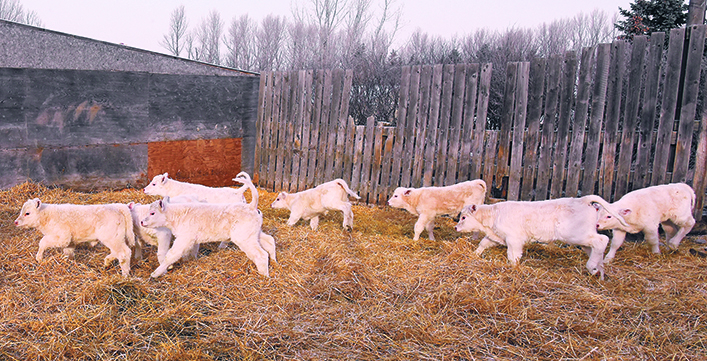
The first is to stay alert for indications that assistance is needed during labour. More than an hour of straining without progress should be investigated.
“If you’re seeing the water bag, (and) if an hour has passed and you do not see feet, then that’s generally a good sign for intervention.
“If you see feet within that hour and then you’re not seeing knees and a nose and tongue, that cow has stalled out on calving and that’s a good indication that intervention is needed.
“If you see the head coming out but the cow keeps straining and an hour goes by, at any point when we have a stalling of labour, that’s a good indication that intervention is needed.”
Cleanliness is an important part of an intervention and doing a vaginal check. Scrub the cow’s hind end with a cleaning solution and wear an obstetric glove to determine whether there is trouble with the calf.
“If we’re going in clean, we’re not going to cause any harm by doing a vaginal exam. It’s OK to feel. You’re not going to cause any harm.
“But if you do need to manipulate, that’s another good indication that we need to just take note of the time and hit the stopwatch and give ourselves 30 minutes,” he said.
If the calf isn’t born by then, call a veterinarian.
“I always, as a veterinarian, have the best success in being able to have the perfect outcome, which means a live calf and a live healthy cow, when intervention is done earlier versus later,” said Creelman.




